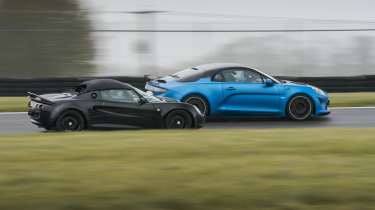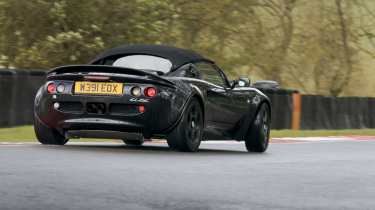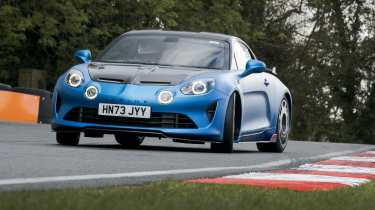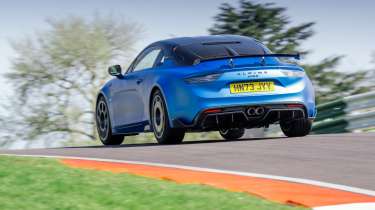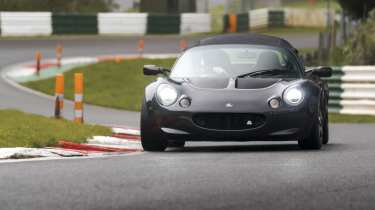Analogue Lotus Elise v Alpine A110 R: £100k lightweight specials go head-to-head
No-expense-spared restomod Elise by Analogue Automotive makes an intriguing pairing with the lightweight, track-focused A110 R
POP! The noise takes me by surprise. At first I worry that a tyre’s blown or some piece of unseen debris has struck the Elise’s aluminium underbelly. I slow down and turn the Lotus’s tiny but beautifully formed steering wheel left and right to see if anything feels awry. All seems well, so gradually I up the pace once more, the modified K-series engine barking vocally on the way to its near-7500rpm red line and then, as I hit the brakes, there it is again: POP! Now I know what it is, and it’s cause to grin rather than tip-toe back to the pitlane: the Analogue Automotive Elise SuperSport is spitting flames from its exhausts. Big ones. This no-expense-spared restomod is one potent little car.
You might remember the SuperSport from evo 311, when John Barker and Yousuf Ashraf drove it back to back with Ashraf’s more standard Elise 111S. This is my first time, and settling into its Tillett carbon-shell driver’s seat, surrounded by neatly finished carbon trim and bespoke switchgear in place of the original Peugeot-sourced items, it feels a cohesive product rather than a tuning project. Which is Analogue’s aim: to comprehensively restore and rebuild a Series 1 Elise as something tauter, faster, fiercer, without losing its essential character or the uniqueness of its driving experience.
> Ford Focus ST Track Pack v Honda Civic Type R: sharpened Focus tackles the hot hatch king
The cost is the frightening part. Prices for a standard Analogue Elise (refurbished chassis, new suspension, brakes, rebuilt and upgraded powertrain and drivetrain with Quaife limited-slip diff, replacement fuel tank, radiators, retrim, repaint, and more) start at around £75k including donor car; this SuperSport (wider track suspension with new wishbones, bushes, hubs and Nitron dampers, plus the carbon interior package and forged pistons and throttle bodies taking the K-series to 210bhp) totals around £100k.
Setting off, it still has that lighter-than-air feel of a standard S1, albeit with much firmer control weights. Out on the circuit, there’s still roll-steer, and the same general feeling of the car beginning to move in a particularly mid-engined way as you press on, particularly through the high-speed, fully loaded right-left jink of the Gooseneck. I’ve only once previously driven an S1 on track, and I am wary; it’s a car with a reputation for being tricky at the limit. But as you learn the SuperSport, you become more confident in it, trusting of it – and captivated by it.
Returning a best timed lap of 1:42.75, Dickie echoes those thoughts. ‘You have to reset your way of driving a little, because, as the name suggests, it’s an analogue car! You feel the mass move in the higher-speed corners but it never develops into a moment that you would have in a standard S1 Elise. It’s got the underlying grip to absorb the speed you’re putting through it. I love that it retains the feel of an S1 Elise but it’s much better controlled.’
JB is more guarded in his praise, finding a little more understeer in slow- and medium-speed turns than expected, though he adds that with more time Analogue could have tweaked the set-up further. Analogue already has further upgrades up its sleeve and is working on a more track-focused creation called the Sprint, which may weigh as little as 650kg.
Meanwhile, having tuned in to the existing SuperSport’s traits, I get it. I couldn’t countenance the idea of a six-figure Elise before driving it, but as a way of taking this much-loved car and exploring its platform and its potential further, with the offer of what is effectively a brand-new, turn-key, upgraded Elise (at a price), it’s a concept with huge appeal.
Equally, many might find the Alpine A110 R’s price hard to stomach. From a little over £50k for the base A110 to the thick end of £100k for the R is quite a jump. But as we discovered on eCoty 2023, the A110 R is quite a special car. Like the Elise, there’s a rare lightness to its movements and the way it flows down the road. In fact our experiences thus far have found it to be a more captivating car on the road than it is on a circuit, where it’s been impressive but less involving than expected in its baseline factory setting.
This time things might just be different: when the A110 R rolls into the paddock, its wheels are tucked further up into its arches than when we last saw it, and it’s running a little more negative camber. Alpine has enlisted a dynamics engineer to set the car up for Cadwell – not an unsporting move on its part, since several other cars in this test, including the Ariel, Caterham, Radical, Revolution and Elise, have engineers with them, happy to tweak set-up too. The changes to the A110 R’s suspension (ride height, damper clicks and geometry, including camber and toe) are all achievable by an owner, though more easily done in a workshop than trackside.
Earlier this morning the A110 R had been the car I’d chosen for sighting laps while the circuit was still chilly and soaking wet from overnight rain. On scantily treaded Michelin Cup 2 tyres it was quite a handful in terms of front-end grip, or lack of, until the tyres found some heat. Now, with the sun warming and drying the circuit, the A110 R feels fantastic. Compared with the last time I drove it on a circuit, at Anglesey, it feels keener to change direction, and more adjustable too; where it was rather one-dimensional and front-limited, it can be more easily manipulated with a lift of the throttle to tighten its line, and balanced subtly on the power too.
John Barker is similarly taken with the R’s new set-up: ‘It feels phenomenal around here. Around every part of the track it has superb grip and remarkable precision. Plenty of performance too. It’s agile and poised, so you can be consistent and refine your lines each lap, getting closer to the edge of the track, like you’re driving a proper race car. It’s so calm, you can carry speed and dive for the apex on the brakes while already thinking about the exit. Absorbing stuff.’
Just a couple of doubts remain: ‘Do you have to be a dynamics engineer and set it up for every track? Also, it was a stark contrast with how it was in the half-wet/half-dry conditions earlier. It was dreadful then, with no front-end grip…’
Dickie pedals the A110 R to the quickest lap time of the day so far (GT3 RS excepted) with 1:36.28 and emerges full of praise. ‘Once you have heat into the tyres it feels quite close to the 911 GT3 RS in some respects, in that you’re aware of extraordinary grip and corner speeds, but the driving experience is very true to the regular Alpine. It’s found its happy place at Cadwell.’
After nearly springing a surprise at eCoty, missing out on the overall win by 0.6 points, the Alpine could well stage another shock podium on TCoty...
This story was first featured in evo issue 322.
